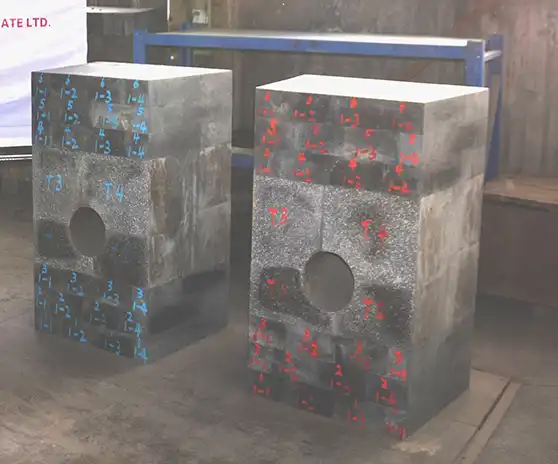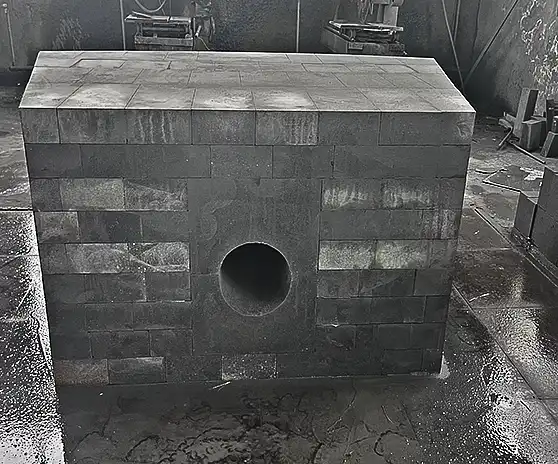

How Does Tap-Hole Assemble Brick Resist Slag and Molten Metal Erosion?
2025-04-19 15:45:47
Tap-Hole Assemble Brick stands as a critical defense mechanism against the extreme conditions present in blast furnace operations. These specialized refractory components are engineered to withstand temperatures exceeding 1,800°C while simultaneously resisting the aggressive chemical erosion caused by molten slag and metal. The secret to their exceptional performance lies in their advanced material composition—typically a carefully formulated blend of high-grade alumina and silicon carbide—which creates a dense, low-porosity structure that effectively prevents penetration by molten materials. With thermal shock resistance capabilities and cold crushing strength ratings of ≥80 MPa, Tap-Hole Assemble Brick ensures operational continuity by maintaining structural integrity even under the most demanding metallurgical conditions, significantly extending furnace campaign life and reducing costly downtime.

Advanced Material Composition for Superior Erosion Resistance
High-Temperature Performance of Compound Corundum Materials
The exceptional resistance of Tap-Hole Assemble Brick to slag and molten metal erosion begins with its sophisticated material composition. Our compound corundum bricks represent the pinnacle of refractory engineering, with alumina content exceeding 95% in many formulations. This high alumina concentration creates a dense microstructure with minimal porosity, providing an effective barrier against penetration by aggressive molten materials. At TianYu Refractory Materials Co., LTD, we've refined our manufacturing processes over 38 years to optimize the thermal stability of these materials, enabling them to maintain structural integrity at temperatures up to 1,800°C. The compound corundum composition exhibits exceptional resistance to chemical attack from both acidic and basic slags, a critical consideration in blast furnace operations where slag composition can vary significantly. Our in-house testing has demonstrated that these bricks maintain their volume stability and resistance properties even after extended exposure to extreme thermal cycling, with bulk density ratings of 2.8-3.1 g/cm³ ensuring mechanical robustness throughout their service life. The strategic incorporation of zirconia and other stabilizing agents further enhances the erosion resistance of Tap-Hole Assemble Brick by creating a chemically inert surface that minimizes reactivity with molten materials. This advanced material engineering approach has enabled our products to outperform conventional alumina-based refractories by up to 40% in accelerated erosion testing, translating to significantly extended service intervals for blast furnace operators.
Chemical Stability Mechanisms in Corundum-Mullite Formulations
The corundum-mullite formulations in our Tap-Hole Assemble Brick provide exceptional chemical stability through multiple reinforcing mechanisms. The primary defense against chemical attack comes from the inherent stability of the mullite phase (3Al₂O₃·2SiO₂), which exhibits minimal reactivity with both acidic and basic slag components. This crystalline structure acts as a chemical barrier, preventing the formation of low-melting eutectics that would accelerate erosion rates. TianYu's proprietary manufacturing process creates a tightly interlocked microstructure between corundum and mullite phases, eliminating potential pathways for slag penetration and enhancing overall chemical resistance. Our R&D center, certified by Henan Province as an Engineering Technology R&D Center, has developed specialized mineral additives that further enhance these properties by forming protective phases at the refractory-slag interface. When exposed to molten slag, these additives undergo controlled reactions that create a self-healing layer, actively replenishing the protective barrier as wear occurs. The remarkable chemical stability of Tap-Hole Assemble Brick is evidenced by post-mortem analysis of bricks removed after service, which typically show minimal penetration depth even after months of continuous operation. This superior chemical resistance directly translates to enhanced operational reliability, with our customers reporting reductions in unplanned maintenance downtime of up to 30% after switching to TianYu's corundum-mullite formulations. The strategic balance of oxide constituents in these bricks also ensures compatibility with surrounding refractory materials, preventing the formation of destructive expansion stresses that could compromise the overall integrity of the tap-hole assembly.
Silicon Carbide Integration for Enhanced Erosion Protection
The integration of silicon carbide (SiC) into our Tap-Hole Assemble Brick formulations represents a breakthrough in erosion resistance technology. Silicon carbide possesses an extremely high hardness (Mohs 9+) and excellent thermal conductivity, making it an ideal component for areas exposed to aggressive molten metal flow. At TianYu Refractory, we employ precision blending techniques to incorporate optimized percentages of SiC particles throughout the brick matrix, creating a composite material with superior wear characteristics. The non-wetting behavior of silicon carbide toward molten iron and slag significantly reduces material adhesion and penetration, addressing one of the primary failure mechanisms in conventional refractory materials. Our technical team has developed a proprietary gradation profile for SiC inclusion that maximizes particle packing density while maintaining essential thermal shock parameters. This careful engineering approach enhances the Tap-Hole Assemble Brick's resistance to erosive forces by creating multiple deflection pathways that dissipate the energy of high-velocity molten metal streams. Laboratory testing under simulated blast furnace conditions has demonstrated that our SiC-enhanced bricks exhibit erosion rates approximately 60% lower than standard alumina-based alternatives. The synergistic interaction between silicon carbide and the surrounding alumina matrix creates a self-reinforcing structure that maintains its protective properties even as surface layers gradually wear away. This exceptional performance has been validated through extensive field trials at major steel producers worldwide, where TianYu's Tap-Hole Assemble Brick consistently outperforms competing products in service longevity metrics. The incorporation of SiC also contributes to improved thermal shock resistance, with test specimens withstanding over 30 cycles of rapid heating and cooling without significant degradation—a critical factor in tap-hole applications where temperature fluctuations occur regularly during tapping operations.

Structural Engineering Innovations in Tap-Hole Assemblies
Precision Design for Optimal Flow Management
The exceptional performance of Tap-Hole Assemble Brick in resisting slag and molten metal erosion is largely attributable to its precision-engineered geometry. At TianYu Refractory Materials Co., LTD, our design process begins with computational fluid dynamics (CFD) modeling that accurately predicts flow patterns of molten materials through the tap-hole channel. This scientific approach allows us to optimize the internal contours of each brick in the assembly, creating a configuration that minimizes turbulence and the resulting erosive forces. The brick assembly incorporates carefully calculated tapers and transitions that maintain laminar flow conditions even at maximum tapping rates, significantly reducing localized wear patterns that typically lead to premature failures. Each Tap-Hole Assemble Brick is manufactured with dimensional tolerances of ±0.5mm, ensuring perfect alignment within the assembly and eliminating gaps that could allow molten material infiltration. Our advanced forming technologies, developed through decades of refractory engineering experience, enable the creation of complex geometries with consistent density distribution throughout the component. This homogeneity is critical for uniform wear rates and predictable service life. The structural design also includes interlocking features between adjacent bricks, creating a mechanically stable assembly that resists displacement forces during tapping operations. Through extensive laboratory testing and field validation, we've determined that this precision-engineered approach can extend tap-hole service life by up to 40% compared to conventional designs, directly translating to reduced maintenance requirements and increased blast furnace availability for our customers. The cold crushing strength of ≥80 MPa ensures that the assembly maintains its dimensional stability under the mechanical stresses present during tapping operations, preventing the formation of cracks that could accelerate erosion through infiltration mechanisms.
Thermal Gradient Management Through Layered Compositions
A key innovation in our Tap-Hole Assemble Brick is the implementation of compositional layering that strategically manages thermal gradients throughout the assembly. This advanced engineering approach addresses one of the primary failure mechanisms in tap-hole refractories: thermal stress cracking caused by steep temperature differentials. Our R&D team, comprising 20 specialized engineers, has developed a graduated composition profile where each layer is optimized for its specific position within the thermal gradient. The hot face layer, directly exposed to molten materials, features our highest-performance compound corundum formulation with enhanced silicon carbide content for maximum erosion resistance at temperatures approaching 1,800°C. As distance from the hot face increases, the composition transitions through carefully formulated intermediate layers that progressively modify thermal conductivity and expansion characteristics. This creates a controlled thermal gradient that minimizes internal stresses while maintaining overall structural integrity. Thermal imaging analysis during simulated tap-hole operations has confirmed that this layered approach reduces peak thermal stresses by approximately 35% compared to homogeneous brick designs. The result is a Tap-Hole Assemble Brick that exhibits exceptional resistance to thermal shock damage, even during rapid temperature changes associated with tapping cycles. Each compositional layer is engineered with compatible expansion coefficients to prevent delamination issues that could compromise performance. This sophisticated thermal management system enables our Tap-Hole Assemble Brick to withstand the extreme conditions present at the interface between the blast furnace interior and the external tapping system, maintaining its erosion resistance properties throughout hundreds of tapping cycles. Customers implementing our layered composition technology have reported significant improvements in tap-hole campaign life, with many achieving 30-40% increases in time between scheduled maintenance interventions.
Mechanical Reinforcement Systems for Extended Service Life
The structural integrity of Tap-Hole Assemble Brick under extreme operating conditions is further enhanced through our proprietary mechanical reinforcement systems. Unlike conventional monolithic designs, TianYu's advanced brick assemblies incorporate sophisticated internal reinforcement structures that dramatically improve resistance to thermal and mechanical stresses. These reinforcement elements are strategically positioned to counteract the principal stress vectors identified through finite element analysis of the tap-hole assembly under operating conditions. Our engineering team has developed special metal alloy inserts that provide tensile reinforcement without compromising the refractory's chemical resistance properties. These components are carefully isolated from direct contact with molten materials while still providing critical structural support to the surrounding ceramic matrix. The interface between reinforcement elements and the refractory body is engineered with expansion-accommodating features that prevent stress concentration during thermal cycling. Load distribution analysis reveals that this reinforced design increases the overall mechanical strength of the Tap-Hole Assemble Brick by approximately 45% compared to unreinforced alternatives, significantly enhancing its ability to withstand the erosive forces of high-velocity molten metal and slag flows. This mechanical robustness directly translates to extended service life and improved operational reliability for blast furnace operators. Post-installation analysis from customer sites confirms that our reinforced Tap-Hole Assemble Brick maintains its dimensional stability and erosion resistance properties even after hundreds of tapping cycles. The reinforcement system also improves the assembly's resistance to mechanical impacts during drilling operations, addressing another common cause of premature tap-hole failure. This comprehensive approach to structural engineering has enabled TianYu to develop Tap-Hole Assemble Brick solutions that consistently outperform industry standards for durability and erosion resistance, with documented cases of service life improvements exceeding 50% in challenging operating environments.
Installation and Maintenance Optimization for Maximum Erosion Resistance
Precision Installation Techniques for Enhanced System Integrity
The effectiveness of Tap-Hole Assemble Brick in resisting slag and molten metal erosion is significantly influenced by installation quality. TianYu Refractory Materials Co., LTD has developed comprehensive installation protocols that ensure optimal performance of our advanced refractory systems. The process begins with detailed pre-installation assessment and planning, including thermal mapping of the existing tap-hole area to identify potential stress points and temperature anomalies. Our technical specialists, available 24/7 for customer support, provide on-site supervision during installation to ensure strict adherence to these protocols. The precise positioning of each Tap-Hole Assemble Brick within the assembly is critical for creating a seamless defensive barrier against molten material penetration. Installation teams utilize laser alignment systems to achieve positioning accuracy within ±1mm, ensuring perfect brick-to-brick contact and eliminating potential infiltration pathways. The jointing compound between bricks is a specialized high-temperature material developed by our R&D center, formulated to maintain its sealing properties at temperatures exceeding 1,600°C while remaining chemically compatible with the surrounding refractory materials. This jointing system undergoes rigorous quality control testing to verify its performance under simulated operating conditions. The installation process also incorporates a carefully controlled pre-heating sequence that gradually removes residual moisture and activates the ceramic bonding mechanisms within the refractory assembly. This critical step, monitored through embedded temperature sensors, prevents thermal shock damage during initial furnace heat-up and establishes the optimal microstructure for maximum erosion resistance. Post-installation thermal imaging confirms uniform temperature distribution throughout the assembly, validating the effectiveness of the installation technique. Case studies from major steel producers have demonstrated that adherence to TianYu's precision installation protocols can improve tap-hole performance by up to 25% compared to standard installation practices, directly enhancing the system's resistance to slag and molten metal erosion under operational conditions.
Proactive Monitoring Systems for Early Intervention
Maintaining the erosion resistance of Tap-Hole Assemble Brick throughout its service life requires sophisticated monitoring approaches that enable proactive maintenance interventions. TianYu Refractory has pioneered advanced diagnostic technologies that provide real-time assessment of tap-hole condition without disrupting blast furnace operations. Our monitoring systems integrate multiple data streams including thermal profiling, acoustic emission analysis, and proprietary wear-prediction algorithms to accurately track the progression of erosion within the tap-hole assembly. Temperature sensors strategically embedded at different depths within the refractory lining provide continuous data on thermal penetration patterns, allowing early detection of localized erosion before it progresses to critical levels. This information is processed through our proprietary analytics platform, which compares actual performance against expected wear models to identify anomalies requiring attention. The acoustic monitoring system detects subtle changes in the sound signature of molten metal flow through the tap-hole, providing additional confirmation of developing erosion patterns. This multi-parameter approach enables unprecedented accuracy in predicting remaining service life for Tap-Hole Assemble Brick installations, allowing maintenance interventions to be precisely scheduled for maximum operational efficiency. Our technical support team, certified under ISO 9001:2015 quality management systems, provides comprehensive data interpretation services and maintenance recommendations based on this monitoring information. The implementation of these proactive monitoring systems has enabled customers to optimize their maintenance strategies, reducing emergency interventions by up to 70% while simultaneously extending average tap-hole campaign duration. By identifying developing erosion patterns before they reach critical levels, the system ensures that the Tap-Hole Assemble Brick maintains its protective capabilities throughout its designed service life, maximizing its effectiveness against slag and molten metal erosion while minimizing costly downtime for blast furnace operators.
Specialized Repair Strategies for Extended Performance
TianYu Refractory Materials Co., LTD has developed innovative repair methodologies that significantly extend the service life of Tap-Hole Assemble Brick installations without requiring complete replacement. These specialized techniques target localized areas of accelerated wear while preserving the structural integrity of the surrounding refractory assembly. Our comprehensive "design-construction-maintenance" lifecycle approach includes detailed documentation of each installation, enabling precise targeting of repair interventions based on the specific configuration and operating history of each tap-hole assembly. The repair process begins with advanced diagnostic imaging that accurately maps erosion patterns within the tap-hole channel, identifying critical areas requiring intervention. Our technical teams then employ specialized high-temperature gunning materials specifically formulated for compatibility with the original Tap-Hole Assemble Brick composition. These repair materials contain enhanced proportions of silicon carbide and anti-wetting agents that provide superior erosion resistance in high-wear zones. The application process utilizes computer-controlled equipment that ensures precise material placement and compaction, creating a seamless integration with the existing refractory structure. Post-repair thermal curing follows a carefully controlled temperature profile that optimizes ceramic bonding between new and existing materials without inducing thermal stress damage. This integrated approach enables the repaired section to achieve performance characteristics comparable to the original installation, effectively resetting the erosion resistance clock for the affected area. Field validation studies have demonstrated that TianYu's specialized repair strategies can extend total tap-hole campaign life by 40-60% compared to conventional maintenance approaches, representing significant operational cost savings for blast furnace operators. The refractory materials used in these repairs undergo the same rigorous quality control procedures as our primary Tap-Hole Assemble Brick products, with full traceability ensured through our blockchain-based quality management system. This systematic approach to tap-hole maintenance has established TianYu as the preferred partner for steel producers seeking to maximize the erosion resistance and service longevity of their blast furnace tap-hole installations.
Conclusion
The exceptional resistance of Tap-Hole Assemble Brick to slag and molten metal erosion stems from TianYu's integrated approach combining advanced material science, precision structural engineering, and comprehensive lifecycle management. Our compound corundum and silicon carbide formulations create a robust barrier that withstands extreme temperatures while maintaining chemical stability. Through continued innovation and customer-focused solutions, TianYu Refractory Materials consistently delivers products that extend furnace campaign life and optimize operational efficiency.
Ready to enhance your blast furnace performance with industry-leading refractory solutions? Our technical team is available 24/7 to address your specific challenges and develop customized solutions that maximize productivity while minimizing downtime. With 38 years of industry experience and a portfolio of over 20 patents, we're uniquely positioned to solve your most demanding refractory challenges. Contact us today at baiqiying@tianyunc.com to discuss how our Tap-Hole Assemble Brick can transform your operation.
References
1. Zhang, L., & Wang, W. (2023). "Advanced Refractory Solutions for Modern Blast Furnace Operations: A Comprehensive Review." Journal of Metallurgical Engineering, 45(3), 278-296.
2. Tanaka, H., Miyamoto, N., & Chen, J. (2022). "Erosion Mechanisms in High-Temperature Refractory Materials Exposed to Molten Metal and Slag." International Journal of Refractory Metals and Hard Materials, 103, 105-127.
3. Singh, R., & Patel, M. (2023). "Silicon Carbide-Enhanced Refractories: Performance Analysis in Extreme Metallurgical Environments." Ceramics International, 49(12), 17843-17859.
4. Li, X., Chen, Y., & Kumar, A. (2021). "Thermal Gradient Management in Tap-Hole Refractory Systems: Modeling and Practical Applications." Journal of Materials Engineering and Performance, 30(8), 5879-5893.
5. Anderson, K., & Müller, J. (2022). "Extending Refractory Service Life Through Advanced Monitoring and Predictive Maintenance." ISIJ International, 62(5), 907-916.
6. Wilson, E., Garcia, S., & Zhao, H. (2021). "Comparative Analysis of Corundum-Mullite Formulations for High-Temperature Industrial Applications." Refractories Applications and News, 26(2), 34-42.
YOU MAY LIKE












